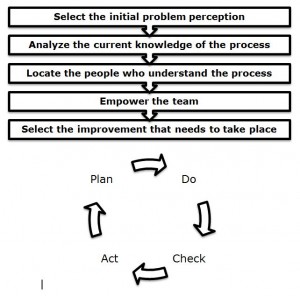Marketing with PDCA is about managing a value stream using PDCA (Plan-Do-Check-Act). Using the new SALES PDCA Framework throughout the marketing cycle will provide constant feedback from customers, and can only occur if they are part of the process. It is about creating value in your marketing that a customer needs to enable him to make a better decision.
Targeting that value proposition through the SALES PDCA methods described in this book will increase your ability to deliver quicker and mor e accurately than your competitor. It is a moving target and the principles of Lean and PDCA facilitate the journey to customer value.
e accurately than your competitor. It is a moving target and the principles of Lean and PDCA facilitate the journey to customer value.
This book also introduces the Kanban as a planning tool or, as I like to think about it, as an execution tool. Improving your marketing process does not have to constitute wholesale changes nor increased spending. Getting more customers into your Marketing Kanban may not solve anything at all. Improving what you do and increasing the speed that you do it can result in an increase in sales and a decrease in expenses.
Table of Contents
- Lean Marketing House
- Future of Marketing
- Marketing Funnels
- Cycles to Loops
- Knowledge Management
- PDCA
- Sales and Marketing Teams
- Kanban
- SALES PDCA
- Marketing with PDCA Summary
- Marketing with PDCA Case Study
- Constancy of Purpose
- Marketing with Lean Program Series
Download the Marketing with PDCA PDF
SALES PDCA is the framework I use for the process that takes place in the customer groups. It is nothing more than a standard PDCA cycle except the SALES part of the framework is where the sales team gets its directions and coaching from the team coordinator and value stream manager. Within the actual PDCA stage the sales team is empowered to make their own choices and determine their own direction to accomplish the goals of that cycle. This framework is introduced in the Marketing with PDCA book.
The individual stages of the SALES – PDCA framework are as follows:
Select the initial problem perception
Analyze the current knowledge of the process
Locate the people who understand the process
Empower the team
Select the improvement that needs to take place
Plan the improvement that needs to take place and plan the change
Do it the new way, execute the plan.
Check the results of the plan to determine whether the plan worked.
Act on the results. If the plan worked, standardize the change. If it didn’t work, readjust and go through the cycle again.
Lean Sales and Marketing is built upon the philosophy that there has been a subtle shift to knowledge as the way to engage, develop and retain your customer base. The sales and marketing team must act as a vehicle to cultivate ideas not only within their four walls but more importantly from their customers and markets. If this is true, how do create new knowledge? How do we learn? Most studies show that we learn best by doing and by being forced to resolve our perspective with those of others who disagree with us. This means that you have to encourage contradictions and be willing to push the envelope with your customers.
This is a strange paradox. Disagreement with your customer can hardly be seen as a positive mechanism for sales and marketing. However, it is the embracement of this understanding that will move your sales and marketing efforts to a higher level of performance.
Can you disagree with a customer? Can you purposely cause tension? You must! You must move away from the comfort zone and create a healthy tension and instability in your sales and marketing process. The first step in doing this is that you must create an atmosphere of respect. It is such an important function of Lean Sales and Marketing that I asked Dr. Michael Balle to define respect within a Lean Company. This is what he said:
The next step in the process is surprisingly easy but difficult to do. It is the process of reflection or in Japanese, hansei. There are three key components of hansei:
- Recognize that there is a problem – a gap between expectations and achievement – and be open to negative feedback.
- Voluntarily take responsibility and feel deep regret.
- Commit to a specific course of action to improve.
The first step, acknowledge that there is room for improvement is not that difficult. However, putting a number to it may be a different story. When we create a performance gap we identify 2 things, one where we are at now and where do we want to go. Of course, we may not get there overnight but there will be limitations. You have to determine what is realistic to achieve. A simple but effective way of looking at it is, “From what to what by when”.
The second step can simply be stated – don’t look for excuses. Take responsibility, feel a little humility and move forward. Without this, you will never fully release from the past and it may be much more difficult to bring fresh ideas to the table.
This is your action plan to move forward. However, without step 2, you will seldom be passionate about step 3. It will just be another effort and ownership will be limited. Ownership cannot be done without an emotional attachment.
The steps of Respect first, Reflection second will drive the 3rd step of Kaizen or continuous improvement. This is the process and culture of PDCA in your marketing cycle. It is the embodiment of tension, a performance gap to send you off on a new path. This path acts as expanding spiral of co-creation of knowledge with your customer that will be truly valued. THE ABILITY TO SHARE AND CREATE KNOWLEDGE WITH YOUR CUSTOMER is the strongest marketing tool possible.
Few companies will take this path. Few companies will take the time to develop the level of respect required. Even fewer will use hansei and look at performance gaps releasing their own pre-determined reasons. Few will ever practice continuous improvement in sales and marketing.
Will you?
“Lean is not a revolution; it is solve one thing and prove one thing.” – Dr. Michael Balle

